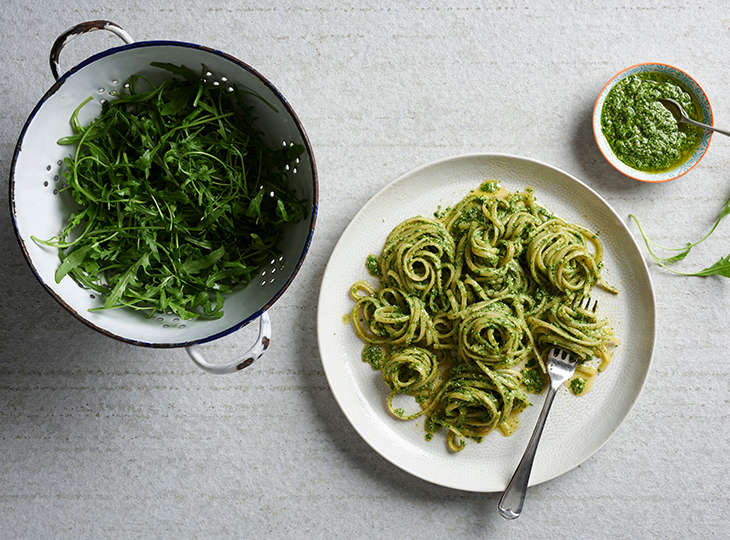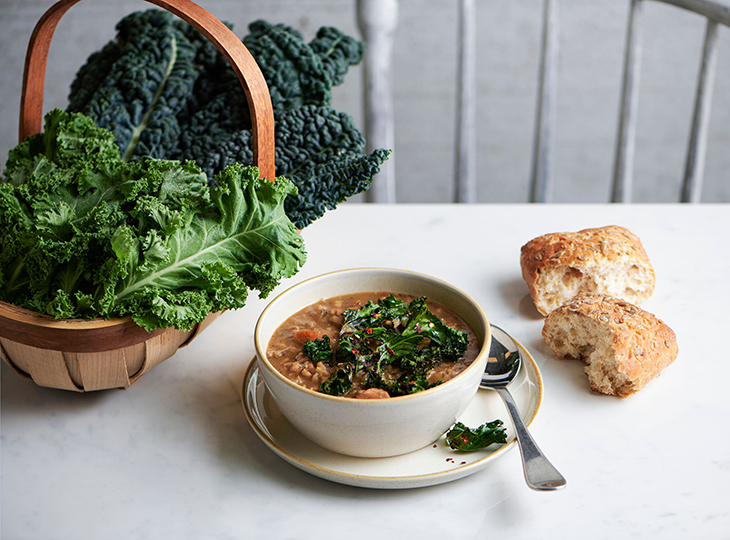Countless people have found solace in their gardens during the pandemic, with many relishing in the positive impact plants have had on their wellbeing.
Garden designer Alan Williams is an expert when it comes to creating gardens packed with edibles. In case you’re inspired to grow ingredients for the first time yourself, here are some easy ones to start with.
1. Rocket

“This salad crop is quick and easy to grow, sow every two weeks for a continuous harvest,” says Mr Williams. “Remove flower stalks to prolong leaf production, unless you want to eat the flowers and seed pods too – both are edible.”
Rocket pesto, drizzled over salads or stirred through pasta, is a great way to use it up.
Parsley Box food development expert Cassandra Suddes says: “Combine 50g pine nuts, 100g rocket, 50g parmesan, 150ml olive oil and a garlic clove in a blender. Season and blend to a paste. It will keep in the fridge for up to five days.”
2. Chillies
“Chillies are so easy to grow, with varieties from mild to mouth-melting. Shatta is a Palestinian fiery chilli condiment for meats, salads and sandwiches,” says Mr Williams.
To make a tasty dressing, Ms Suddes suggests: “Thinly slice 250g red or green chillies, keeping the seeds. Mix with one tablespoon of salt, place in a sterilised jar, seal and store in the fridge for three days. Drain and blitz to a rough paste. Add three tablespoons of cider vinegar and one tablespoon of lemon juice, mix and return to the same jar. Pour enough olive oil over the surface to seal and keep in the fridge.”
3. Kale

The Nero di Toscana variety is delicious and easy to grow.
To make kale chips, strip leaves from the stalks and midribs. Wash, dry and tear into slightly larger than chip-sized pieces, says Ms Suddes.
“Toss in a large bowl with extra-virgin olive oil and salt. Massage the leaves to coat evenly. Spread onto baking trays in single layers. Don’t crowd them or they won’t dry evenly. Bake for 20 minutes at 160°C. Allow to cool, then store in an airtight container for a few days. They’re great for snacking or adding to soups,” she says.
4. Lavender
If you’ve never eaten lavender before, try Lavender Rice Pudding.
Ms Suddes says: “Heat one litre of milk, with one teaspoon culinary lavender in a saucepan until just boiling. Remove from the heat, cool to room temperature (10-15 minutes) and strain.
“In a large saucepan, bring 220g of pudding rice, six tablespoons of honey, and the infused milk to boil over medium-high heat. Reduce heat, cover, and simmer for 25 minutes, stirring occasionally until the rice is tender and creamy. Add one-and-a-half teaspoons of pure vanilla extract, 250ml double cream and a knob of butter.
“Cook for five minutes, stirring constantly, adding honey to taste. Remove from the heat and serve.”
Read: How to dry and store fresh garden herbs
5. Edible pelargonium

These colourful plants can be used to flavour cakes and cocktail syrups. “Use the leaves in a classic lemon drizzle mix and dress the cake with its pretty petals,” Ms Suddes suggests.
6. Mint
“Grow mint in pots indoors or outdoors in moist but well-drained soil in full sun to partial shade,” suggests Mr Williams.
A classic mint chutney is great with samosas and pakoras. It also works well on wraps or roasted vegetables.
“Place 75g coriander, 55g mint leaves, two deseeded green chillies, a one-inch (2.5cm) piece of ginger, 60ml fresh lime juice and three tablespoons of rice vinegar in a blender and pulse until they form a rough paste,” suggests Ms Suddes. Season and place in an airtight container and use within three days.
7. Tomatoes

“These colourful fruits are happy in pots, grow bags and even hanging baskets,” says Mr Williams.
Read: Imaginative ways to use grow bags in small spaces
To make buttered tomatoes with ginger, Ms Suddes says to heat two tablespoons of butter in a large pan and add two thinly sliced spring onions, plus 1.5cm of peeled ginger cut into matchsticks.
Cook for one minute, stirring often. Add 300g of tomatoes (cut into 2.5cm pieces) and cook, turning gently with a spoon, until juicy and just warmed through, about two minutes. Add one tablespoon of soy sauce and toss.
Season to taste. Spoon the tomatoes over toast, meats and grilled halloumi, serve with rice or stir through pasta.
8. Tarragon
Tarragon is perfect with chicken, broad beans, tomatoes, cream, green beans, leeks and potatoes and delivers a wonderfully smoky aniseed flavour.
“Open a bottle of white wine vinegar and add four to six large sprigs of tarragon and reseal. Leave for five to seven days and then check the flavour daily until you’re happy,” says Ms Suddes. “Don’t leave it longer than two weeks. Remove the tarragon and discard. Use the vinegar in dressings, salads, sauces and chutneys.”
9. Carrots

“Carrots need deep soil to grow well, but there are short-rooted varieties which do well in containers,” says Mr Williams.
Quick pickled carrots are easy to make. Add them to sandwiches for a little acidic bite, or toss them with sesame seeds and herbs for a colourful salad.
“Boil 100g of sugar with 200g of water, 100g white wine vinegar and 20g salt, then chill. Create carrot ribbons from three carrots and add them to the cooled vinegar mixture. Leave for 24 hours to pickle. For more flavour, add whole cumin, coriander and fennel seeds to the pickling vinegar,” says Ms Suddes.
Read: How to grow new vegetables from kitchen scraps
10. Lemon verbena
Lemon verbena is a very versatile herb; it can be used to make flavourful olive oil-based salad dressings, subtle lemon ice cream, refreshing teas and lemon verbena jelly, as well as season poultry dishes, salsa verde and soups.
What do you grow at home? What do you find easiest to grow? Share your thoughts in the comments section below.
– With PA
If you enjoy our content, don’t keep it to yourself. Share our free eNews with your friends and encourage them to sign up.

